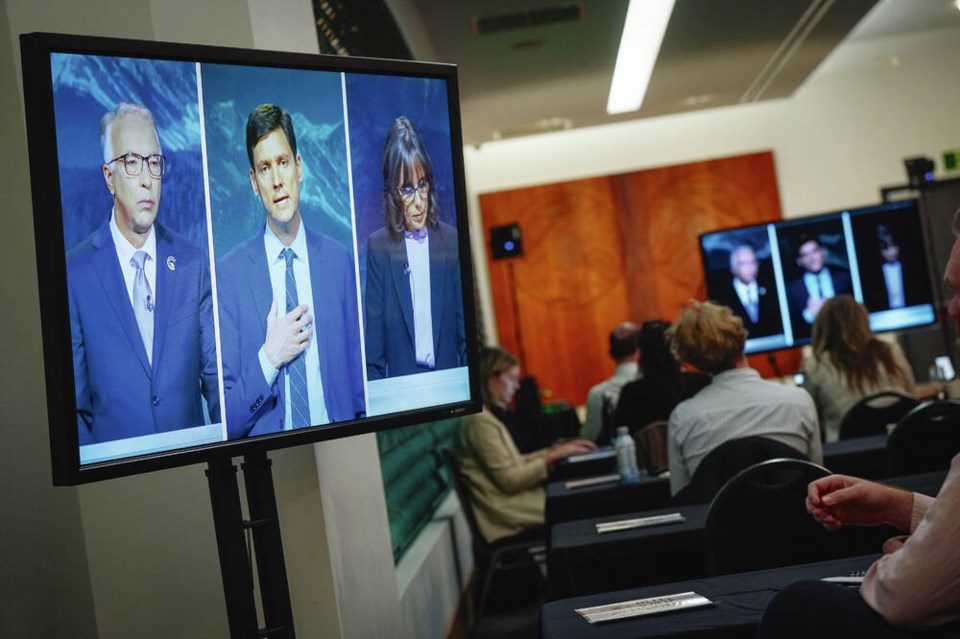Televised debates in Canadian provincial and federal elections present a chance for the challenger—usually the leader of the official Opposition—to be seen as a capable head of government. For Conservative Party of B.C. Leader John Rustad, the events that transpired inside CBC’s Vancouver studio last week will most likely be regarded as a lost opportunity to establish an emotional connection with the electorate.
The B.C. Conservatives reached the debate in a statistical tie with the governing BC New Democratic Party (NDP). The onus was on Rustad to seal the deal, to convince undecided voters that change was necessary and to go beyond the focus of the early stages of the campaign: mistrust of the current premier.
Over the long weekend, Research Co. asked likely voters in British Columbia about the impending election. Support for the BC NDP remained at 45 per cent province-wide, but the BC Conservatives fell three points to 41 per cent. The BC Green Party improved to 11 per cent, while other parties and independent candidates are backed by three per cent of likely voters at this point.
The personal numbers for BC NDP Leader David Eby did not move much. His approval rating is 53 per cent (up one point). BC Green Leader Sonia Furstenau gained three points (45 per cent). Rustad dropped three points to 42 per cent. This question sums up who connected, who did not and who did not have to.
For longtime observers of politics in this province, polarization is not unusual. BC Liberal voters in 2005 and 2009 despised Carole James, and BC NDP voters in the same election returned the favour (so to speak) to Gordon Campbell. A gender gap—with the exception of the massive majorities earned by Campbell in 2001 and John Horgan in 2020—has also been a consistent feature of politics in British Columbia.
What makes this democratic process unique is the steady level of support that the BC NDP is getting among decided voters aged 55 and over. With just days left in the campaign, the governing party is backed by 53 per cent of the province’s oldest, and traditionally most reliable, voting demographic. The BC Conservatives are a distant second with 35 per cent.
Rustad, while clearly surpassing the level of support that former BC Liberal leader Andrew Wilkinson had in the last election fought by his party four years ago (34 per cent), has not been able to climb the ladder on the “Best Premier” question. Eby remains ahead of him on this indicator (40 per cent to 31 per cent), with Furstenau at 14 per cent.
There might still be a chance for the BC Conservatives to narrow the gap if reaction to their platform release is positive. Still, the election has so far been fought under one rationale. The efforts from the Conservatives to paint Eby as out of touch and lacking “common sense” have not drastically changed the perceptions of residents. Rustad’s own personal numbers have descended as residents get to know him. There may be more than one voter out there who assumed the “provincial Conservatives” were represented by Pierre Poilievre. Having prospective federal candidates knock on doors at the same time as provincial contenders may have inadvertently added to this confusion.
At any rate, the debate appears to have given Furstenau a boost, even if some voters will be unable to find a BC Green candidate on their ballot. The BC Conservative war room, which was quick to issue a celebratory tweet after the radio debate, was conspicuously quiet after the televised version. In our question on character traits, Rustad fell to 42 per cent (down four points) on “being a good speaker and communicator” and jumped to 44 per cent (up four points) on “being patronizing.”
These are not numbers that suggest a successful introduction to provincial voters.
A four-point lead at the province-wide level still means the provincial election is close. This is the same advantage that the BC Liberals enjoyed over the BC NDP in the elections won by Campbell against James (46 per cent to 42 per cent in both 2005 and 2009). Those campaigns were dominated in the latter stages by a governing party that knew which doors to knock on and what messages to highlight, and an opposition whose attempt to turn the campaign into a discussion about personality and aloofness fell flat. It will be a significant challenge for the organizers of past BC Liberal campaigns to seek victory while relying on the playbook they used to decry.
Mario Canseco is president of Research Co.
Methodology: Results are based on an online survey conducted from October 12 to October 14, 2024, among a representative sample of 800 likely voters in British Columbia. The data has been statistically weighted according to Canadian census figures for age, gender and region in British Columbia. The margin of error—which measures sample variability—is +/- 3.5 percentage points, 19 times out of 20.

.jpg;w=120;h=80;mode=crop)

